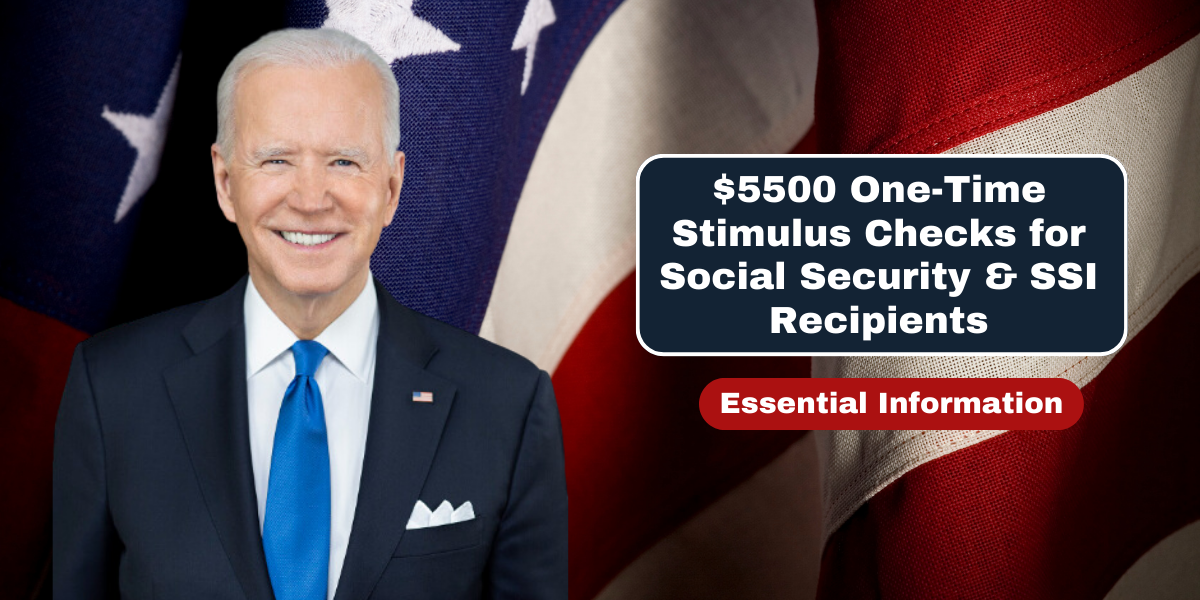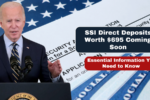The House of Representatives has approved a significant financial relief measure: a $5,500 one-time stimulus check for Social Security and Supplemental Security Income (SSI) recipients. This payment aims to provide crucial support to individuals on fixed incomes amid ongoing economic challenges.
Recipients include those who receive Social Security or SSI benefits. Payments began in mid-August 2024 and are being issued via direct deposit, Direct Express cards, or paper checks. If you haven’t received your check yet, check your eligibility, use the IRS “Get My Payment” tool to track it, and allow for some processing time before reaching out for assistance.
Table of Contents
What Is the $5500 One-Time Stimulus Check?
The $5,500 stimulus check is a one-time payment specifically for Social Security and Supplemental Security Income (SSI) beneficiaries. This financial aid is intended to help individuals on fixed incomes cope with the increasing costs of living and ongoing economic challenges.
The initiative provides crucial support to those who rely on these benefits as their primary source of income. Payments began in mid-August 2024 and are distributed through direct deposit, Direct Express cards, or paper checks. If you are eligible and haven’t received your payment yet, use the IRS “Get My Payment” tool to track it and ensure that you receive this much-needed relief.
Key Details of the Payment
- Amount: $5,500 per recipient
- Eligible Recipients: Social Security and SSI beneficiaries
- Distribution Date: Payments started in mid-August 2024
- Mode of Payment: Direct deposit, Direct Express card, or paper checks
This financial assistance is meant to alleviate some of the financial pressures faced by those on fixed incomes.
| Per Hour Minimum Wage In Ontario |
| Dwp 600 Per Month For Pensioners |
| Subaru Battery Settlement 2024 |
| 3200 Oas Deposits For Seniors In August |
| Canada Prime Rate Increase 2024 |
Who Qualifies for the $5,500 Stimulus Check?
To receive the $5,500 stimulus check, you must be a recipient of Social Security or Supplemental Security Income (SSI).
Eligibility Criteria
- Social Security Recipients:
- Includes retirees, disabled individuals, and others who receive Social Security benefits.
- SSI Recipients:
- Individuals with limited income and resources who receive Supplemental Security Income.
Payment Mode and Distribution
- Direct Deposit: For those who have provided their bank details.
- Direct Express: Payments deposited onto Direct Express debit cards.
- Paper Checks: For individuals without direct deposit arrangements.
When Will You Receive Your Payment?
The distribution of the stimulus checks began in mid-August 2024. Payments are being sent out in stages to ensure a smooth process.
Tracking Your Payment
To track your payment, use the IRS’s “Get My Payment” tool available on their official website. This tool provides real-time information about your payment status and delivery method.
Common Reasons for Delays
- Bank Account Issues: Incorrect or outdated bank information may delay direct deposits.
- Mail Delays: Paper checks can be delayed, especially in rural areas.
- Eligibility Verification: Some payments might be delayed due to additional verification processes.
What to Do If You Haven’t Received Your Payment
If you have not received your $5,500 stimulus check yet, there is no need to worry immediately. The IRS has suggested allowing several weeks after the official distribution start date before reaching out.
Steps to Take
- Verify Your Eligibility: Confirm that you meet all eligibility criteria.
- Check Your Payment Status: Use the IRS’s “Get My Payment” feature.
- Allow for Processing Time: Be patient, as some payments may take longer due to processing or mailing delays.
Impact of the Stimulus Payment
- Financial Relief: The $5,500 one-time stimulus payment helps Social Security and SSI beneficiaries cover essential expenses, reduce debt, and save for future needs.
- Support for Fixed Incomes: Provides crucial assistance to those who rely on Social Security and SSI as their primary source of income.
- Economic Stimulus: The influx of funds is anticipated to boost economic activity by increasing spending on necessities.
- Expenditure Focus: Recipients are expected to use the funds for groceries, medical bills, and other essential costs.
- Growth Potential: This increased spending can stimulate economic growth by enhancing consumer demand and supporting local businesses.
Conclusion
The $5,500 one-time stimulus payment is a crucial measure aimed at offering substantial financial relief to individuals facing economic difficulties. Designed to support those on Social Security and SSI, this payment addresses pressing needs by helping with essential expenses and reducing financial burdens.
To maximize the benefits of this stimulus, it’s important to confirm your eligibility and monitor the status of your payment. Utilizing the IRS “Get My Payment” tool can provide updates and ensure you receive this vital assistance in a timely manner. Staying informed will help you effectively manage the relief and make the most of this economic support.
FAQs
How can I check if I’m eligible for the $5,500 stimulus check?
To check your eligibility, confirm that you are a current recipient of Social Security or SSI benefits. If you are, you should receive the payment automatically. Use the IRS “Get My Payment” tool for real-time status updates.
What should I do if I haven’t received my payment yet?
If your payment is delayed, first verify your eligibility and check the status using the IRS tool. If there are still issues after a few weeks, contact the IRS for further assistance.
Will the $5,500 stimulus check affect my taxes?
The $5,500 stimulus check is not considered taxable income. It is a one-time financial aid measure and should not affect your tax return or require repayment.






